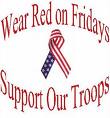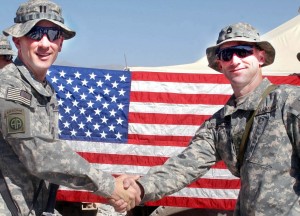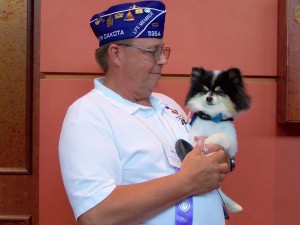Sep
30
Red Fridays
Filed Under American Patriotism, Events, Today's War | Comments Off on Red Fridays

RED FRIDAYS —– You will begin seeing a great many people wearing Red every Friday.
The reason?
Americans who actively support our troops used to be called the ‘silent majority’. We are no longer silent, and are voicing our love for God, country and home in record breaking numbers.
We are not organized, boisterous or over-bearing. We get little media coverage on TV, to reflect our message or our opinions.
Many Americans, like you, me and our friends, simply want to recognize that the vast majority of Americans support our troops.
Our idea of showing solidarity and support for our troops with dignity and respect starts on Friday – and continues each and every Friday until the troops come home from war.
Every red-blooded American who supports our men and women afar should consider wearing something red.
A bunch of us are doing this.
Please join us.

Sep
29
by Janet Seahorn

Have you ever heard a song a hundred times and never thought much about it?
Then one day, you are driving down the road with nothing to obscure your mind; you hear this very same song and it suddenly hits a new note, a new way of thinking about the words, and you wonder why did I never recognize the amazing connection?
Such an incident came to me a week ago while I was steering down the highway. I heard a song from Josh Groban’s album, Awake, called “Weeping”. What took me by surprise was how closely the words seemed to describe the silent torment of trauma.
How experiencing a truly shocking event, the mind, body, and spirit continues to relive the disturbing details as if they were happening in present time.
How, no matter what you try, how much you do to contain or remove the frightening thoughts, they still seem to remain.
The words from the song “Weeping” is another way to describe those living with Post Traumatic Stress. See if you agree – I only wrote down a verse and the poignant chorus.
I knew a man, who lived in fear,
It was huge, it was angry, it was drawing near.
Behind his house a secret place
Was the shadow of a demon he could never face.
He built a wall of steal and flame
And men with guns to keep it tamed…
It doesn’t matter now,
it’s over anyhow,
He tells the world that it’s sleeping.
But as the night came out
I heard a lonely sound
It wasn’t roaring, it was sleeping.
So where are those “secret” places where the demons hide? And, even more important, how many sufferers are strong and courageous enough to face them, deal with them, and move forward?
For there are no walls high enough, no amount of men with guns that will be able to tame one’s internal demons.
In the end, perhaps the residue of trauma isn’t fueled by fear and anger at all; perhaps what remains is fueled by a sense of deep sorrow. A sorrow provoked by dreams of what could have been. Sorrow from what was lost and the silent weeping formed from loneliness and regret.
And perhaps, with enough time, enough support, and enough courage even the weeping will cease and be replaced with hope and joy.
Sep
23
The Teeter Totter Journey
Filed Under Life, PTSD | 2 Comments
 by Janet Seahorn
by Janet Seahorn
Ever think of life as a “teeter totter journey”? Sometimes you’re up, sometimes your down, and when everything is in perfect balance, you are somewhere in-between.
The biggest challenge on a teeter totter is keeping that perfect balance. The certainty of teeter tottering is that equilibrium doesn’t last very long. As soon as the tiniest shift occurs on either side, the mechanism moves.
When you were a child playing on the teeter totter, the fun wasn’t keeping the slab of wood in balance; it was the fast ups and downs as you tried to give your partner a very exciting ride.
Life is a bit like that teeter totter. Some days we are up, some days down, and, every so often, we are within the perfect balance. If we really examined it, however, we would notice that most of our time is spent in the process of moving between the ups and the downs.
This is not good or bad. It just is. Post-Traumatic Stress can be life’s ultimate teeter totter. The ride is faster, quicker, and more unpredictable than the average, and those times of stability may seem shorter. Those individuals on the PTSD cycle are there for good reason; they have experienced life at some of its highest highs, and it very lowest lows. The speed of change, therefore, tends to be faster, more unpredictable. At times it can make one queasy from experience.
Playing on a teeter totter requires at least two people; you can’t get up without someone on the other end helping you there. It’s a push, pull, and bumps boogie.
Those living with Post-Traumatic Stress and family members who become part of the journey often experience the same unpredictable, sudden change in highs and lows. Yet, perhaps, the most important message in this blog is simply this: if either rider decides to abandon the wooden slab, the remaining rider can be at peril, depending on where they sit.
And herein lies both the gift and the tragedy. Those of us who live with the after effects of combat trauma (or any trauma causation) make a choice every single day to continue the journey together.
Yep, life is a teeter totter journey.
Sep
16
The Strength of One
Filed Under Civilian life, PTSD treatment | 6 Comments
-by Janet Seahorn

It had been several months since I last saw him. The end of last semester during finals to be exact. He had been a student in one of my university classes. He was a big, strapping, young man who almost always had a smile on his face and some funny comments to amuse his table mates.
Before that semester began, I knew that several of my new students were National Guard or had served in the military; he was among them. On one occasion, he told me that he had been on active duty and had just returned from a tour in a war zone. Iraq one day, and the next day he was signed up and attending classes at the university. No transition time whatsoever. Yet, he seemed to take it all in stride. He even joined a fraternity.
A few times I had spoken with him about some of his experiences and asked if he knew anything about Post Traumatic Stress. Without much dialogue he nodded and mentioned that he had some symptoms but he was coping quite well. And by all outward appearance and on most days he was fine. Only a few times did I recognize the demons had visited him, but thankfully, they didn’t seem to stay very long.
The semester wore on without much concern until the last month when he was absent a few times – until then he attended every class and only missed on rare occasions. One absence occurred the first day of class. He had e-mailed me ahead of time to let me know he would be missing that session because he was attending the funeral of one of his best friends. Only later did I learn the funeral was a young marine who had been in our local papers and had recently died in Iraq.
The marine had been a close high school friend. They had been star players on their football team, shared Saturday night outings built on a foundation of boyhood friendship.
After our “catch-up” talk, he mentioned that the summer had been tough. He had an accident which broke some bones in his ankle. He could not participate in all of the fun activities that had anticipated during the school year. Given the pain and the down time of recuperation, the memories resurfaced; the trauma of his tour of duty in Iraq, what he saw and had to cope with, the decisions he had to make on a daily basis – returned to haunt him.
Typical of his strong personality, he downplayed most of the symptoms. Yet, this is an intelligent young man. He did not dismiss the symptoms and stated that he was getting help for his PTSD. Just knowing this put my mind at ease. I could only imagine what courage it took to take this step. Hopefully, other vets who know him will follow his example. He will get better – faster, in a healthier manner.
Just a side note: I no longer choose to call this a “disorder”. It seems to me the more I learn and understand this phenomenon, the more I believe that PTS(D) is the minds/body’s incredibly creative way to deal with an unusually horrendous life event.
Had the mind not employed the immediate reaction of numbing and stuffing the event, the person may have died. To avoid the ultimate death sentence, the mind/brain made a split second decision to unconsciously remove itself from the trauma until a later time; a time when the body was safe to explore the event without being in the line of fire.
Pretty amazing and effective when you think about it. If the brain wasn’t such a protective, innovative problem solver many of us would not be around today. Yea, for our amazing brain. Maybe it is not “disordered” at all, just creatively restructured for a bit.
In a few weeks I will attend a conference on Traumatic Brain Injury (TBIs). Of course I will be writing about this experience and sharing some of the information with our blog readers. Stay tuned.
Sep
8
A New Beginning
Filed Under PTSD treatment, Treating PTSD | 1 Comment
-by Janet Seahorn

In a previous blog we wrote about the Wilderness and Healing. Before that we talked about how PTSD + Joy = Peace, Maybe — can move us toward wellbeing.
This week’s focus is a continuation of both ideas, an extension of how we can heal, can move forward and grow healthier. What every suffering person is searching for is a GENISUS – a new beginning, new start, a sort of rebirth.
So this is the big question, “what will be our new beginning after a trauma experience?” Trauma does not have to be the end of living, but a start of living life in a new way. It begins with the seeds we are now and grows into the people we want to become.
Imagine that person, vision it with all the bright pictures, melodies, and glory we can see, hear, and feel in our hearts. New beginnings ask us to examine what we learned from our combat/trauma experience, to go beyond the pain and terrible memories, and to rise above them.
To accomplish this mission will require that we put ourselves fully into the human arena. Isolation is not an option. We cannot lock ourselves away physically or emotionally; that means drugs, alcohol, over-working… are simply not possible choices.
The world is too rich, too interesting, too special to isolate ourselves. Yes, there are horrible things that occur. There is violence, greed, and cruel acts. And for every act of brutality, I believe there are many more acts of kindness, beauty, and love. We must not forget to notice these during our times of darkness. We must attempt to appreciate the goodness in the world. It is present. Just look.
An old saying states, “What we focus on persists”. What do we want to persist? We can focus on those things. Write them up. Put them on our refrigerators, nightstands, even our mirrors. The new us begins today. We choose. By no means will it be easy. The new us will not be perfect, but it will be real.
Like the Velveteen Rabbit, he became worn, torn, and aged only through the experience of being touched, loved, and used. And by going through all of his living, he became real. He developed into being alive, for being alive required a multitude of life events both magnificent and sad.
I am sure that if one were to inspect the experiences of the rabbit, he may have been diagnosed with PTSD. And, I am equally sure, that at the end of his days, he would not have traded these experiences for something easier and less physically or emotionally demanding.
He chose life, and so will we!
Sep
1
Never Apart
Filed Under Dogs, Pets, PTSD treatment, Purple Heart | 1 Comment
by Janet & Tony Seahorn
 It was a small, black & white, furry 5-pound bundle of emotional and physical relief. His name was Petie, the keeper of an adult warrior, Purple Heart, Vietnam Veteran.
It was a small, black & white, furry 5-pound bundle of emotional and physical relief. His name was Petie, the keeper of an adult warrior, Purple Heart, Vietnam Veteran.
The vet trained him as his first alert. An important task. Petie knew when his master needed to take his medications. He would wakeup Dennis at various times in the middle of the night so that specific pills were administered at the most critical time in order to keep the Post Traumatic Stress under control.
Dennis trained Petie especially for this purpose. They are best friends and constant companions, never apart. This small, furry medic is essential, not just for the vet’s physical well-being, but even more important, his emotional/mental stability.
Petie alerts Dennis when there is danger in the surroundings. He watches intently everything that goes on with his owner and around his owner. If Petie isn’t comfortable his master knows to pay closer attention to his current environment. If Petie doesn’t like you, more than likely Dennis isn’t going to become too friendly either.
They coexist, two different species, one functioning entity.
There are numerous organizations that train service dogs. Dogs that serve the deaf, blind, and epileptic individual. Dogs that act as the arms and legs of those who no longer have capacity to move on their own. Now, some of these groups are training dogs to do something even more challenging, knowing when their owner may go into a PTSD anxiety attack.
The dog must sense when such attacks may occur before they actually manifest themselves. They know even before the person that something is coming on – giving their owner an opportunity to breathe, use relaxation techniques, and take medication if necessary. They provide a sense of security and well-being in a world filled with unpredictability and potential stressors.
One such training organization is NEADS – Dogs for Deaf and Disabled Americans.
They are conducting an in-depth study of nine-ten Iraq vets who has severe PTSD. The study’s focus is to evaluate the most effective canine training methods that serve the sensitive needs of a veteran suffering from combat stress.
This is a very expensive and challenging research project because it must take into account the behaviors of two very different organisms: human and canine.
It will be a critical piece of information given the increasing number of individuals returning from the Iraq and Afghanistan theaters and those that have served in past wars such as Vietnam and the Gulf War.
Aug
25
BLANKETS OF HOPE
Filed Under American Patriotism, Quilts of Valor | 1 Comment
 “QUILTS OF VALOR PROJECT”
“QUILTS OF VALOR PROJECT”
During the Purple Heart National Convention we passed a table of women busily sewing and constructing several incredibly beautiful red, white, and blue patriotic quilts. Turns out, these ladies have made and sent to military hospitals throughout the United States and overseas over 415 quilts. The national Quilts of Valor Organization has provided over 17,000 quilts. Frankly, I was stunned by this number given the time, money, and effort that goes into making a hand sewn quilt. Wow!
For that reason, I thought our readers might find it interesting to know some of the facts regarding such a worthy organization. (PS – they greatly need and accept donations to help defray the personal cost and postage for each quilt and quilter). The following information is taken from a brochure given to me by Donna Roche, the Arkansas QOV Coordinator (e-mail diva@mc2k.com)
The Quilts of Valor is our “Purple Heart Award” for service, sacrifice and valor of combat wounded soldiers. It is our way of saying “Thank You for your service, you have not been forgotten.” Numerous people are involved in making the quilts, from contributing quilt blocks, finishing the tops, and then quilting them. Each quilt receives a “Quilt of Valor” label thanking the injured warrior for their dedication and sacrifice. The label contains the name of the maker and the quilter. Sometimes the soldier will send a letter of thanks like the one below:
“My QOV not only keeps me warm when I am cold, it keeps my heart warm too. I’m twenty-four, a husband and father. This may seem childish, but when I get scared with memories of war, I curl up in the quilts and everything goes away. It makes me and the hundreds of wounded I’ve seen feel better knowing there are people in the States that care about us and what we do.”
The Cost of each quilt:
Quilt top $55
Batting $15
Quilt Backing $40
Binding & Notions $10
Pillowcase $ 5
Shipping w/Insurance $10
Total for making a QOV $135
The following poem is dedicated to these amazing women and their loving selfless efforts.
BLANKET OF HOPE
Blanket of Hope
Covers my wounds,
Keeping me safe
In this far from home room.
Blanket of Hope
Surrounding my heart,
Keeping me sane
When I’m falling apart.
Blanket of Hope
Sewn by love’s hands,
With patience and kindness
Compassion commands.
Blanket of Hope
As tears fill my eyes
Brings me closer to home
When morning arrives.
Blanket of Hope
With deep gratitude
My words can’t express
A way to thank you.
Janet J. Seahorn, Ph.D
August, 2009
In honor of the Quilts of Valor Organization
Donations are greatly needed and accepted to help continue this amazing, healing mission.
or Donna Roche, diva@mc2k.com
Aug
18
THE WISDOM OF WARRIORS PAST
Filed Under American Patriotism, Purple Heart | 1 Comment

by Tony Seahorn
Even in the most devastating and pain-filled moments, we have an opportunity to learn something about ourselves, our world, and the human spirit.
Attending the Purple Heart National Convention in Rogers, Arkansas provided an enormous volume of proof supporting this statement. The group was a moving, living sea of purple where great amounts of blood was given in service to our country. Veterans from WWII, Korea, Vietnam, and a few from the current war in Iraq and Afghanistan attended.
It is the Vietnam veteran, however, who have provided evidence of how to do things differently when welcoming a warrior home from combat. These vets had no “welcome home”. Their experience of returning from combat was often met with verbal and sometimes physical abuse. Crowds of protesters were waiting to hurl insults and thoughtlessly displayed signs/banners with obscene language and incredibly cruel remarks and pictures.
What Vietnam vets taught Americans through their touching stories were how badly they were injured – not just by the enemy in a foreign land, but by their own country men. The wound to the soldier was deeper, more personal. It bled into the heart and soul of the veteran and couldn’t heal. Healing requires exposure to the light, the outside air. The Vietnam vets were forced to suppress not only their sacrifice, but their woundedness.
With our present battles in Iraq and Afghanistan, veterans have rallied for a new mission, a promise that never again would our military personnel return home unwelcome. Today there are a multitude of individuals and organizations who support, care and offer hope to serving military members as well as their families. At the Purple Heart Convention we met a few. The “Soldier’s Angels” were there to ensure every military person serving in a combat zone receives care packages, cards, and letters from their fellow Americans. “Quilting for Valor” is another group who painstakingly create beautiful hand-crafted quilts to send to hospitals both in-country and overseas. These quilts cover and comfort the wounded warrior during his/her hospitalization.
And there were others with their own caring mission.
Vietnam veterans taught Americans how words can wound deeper than guns. How lack of support impairs the ability to move forward. And most of all, how to forgive – their country’s leaders, their country men/women, and sometimes even their own families – because they understand that forgiveness heals.
The significant lesson these past warriors, in their aging wisdom learned, then modeled, was the power of absolution, which granted freedom from their emotional woundedness. Then, through such forgiveness, they have and continue to work tirelessly with the American people and the military to meet the needs of the new combat wounded.
America’s new Purple Hearts hopefully feel only the love, support, and generosity of an America who will never again allow our sons and daughters to return home from combat unwelcome.
Aug
12
Wilderness and Healing PTSD
Filed Under Treating PTSD | 3 Comments
 They come at the most unexpected times; the demons, depression, sadness, anxiety… It is the uncertainty of the unwanted feelings, the never knowing for sure when or where they might appear that makes Post-traumatic Stress such a challenge to manage.
They come at the most unexpected times; the demons, depression, sadness, anxiety… It is the uncertainty of the unwanted feelings, the never knowing for sure when or where they might appear that makes Post-traumatic Stress such a challenge to manage.
Modern civilization, with all of its new technologies, now has more clever and massive means to torture and kill. And our conscious and unconscious psyche knows and understands this fact. So why in the heck would someone with PTSD feel secure and at ease in a large city, a crowded mall, or a traffic-filled highway?
Many times it is these modern places that exacerbate PTSD symptoms. Finding a place of safety to escape and heal may be to retreat to the wilderness. A place where Mother Nature opens her soft arms to surround us with peace, soothe our torn nerves, and comfort us with gurgling mountain streams, meadows splashed with abundant colors, greens so bright that they almost appear painted. Soft breezes and tiny birds sing a lullaby so sweet that we almost weep with gratitude. Compassionate, wilderness spirits seem to enfold our entire bodies and minds with their loving presence.
This summer we have been fortunate to spend a great deal of time in the mountains: camping, fishing, hiking, floating rivers. Each experience reinforced what we have always known – wilderness places heal.
There is a healing that takes place in the wilderness. Where hatred, greed, and meaningless violence cease to exist. When we are surrounded by wilderness our senses open up to drink in the sights, sounds, smells, tastes, and textures that quiet our minds, hearts, and tattered spirits.
Nature allows us to relax, to rejuvenate. It is why we are blessed to visit each special, wild place. We are privileged to experience natural environments and acknowledge the value of these common places becoming our sacred, healing grounds.
Please send us stories of your wilderness, healing places. We would enjoy hearing from you.
Aug
5
PTSD + JOY = PEACE… May be
Filed Under Treating PTSD | Comments Off on PTSD + JOY = PEACE… May be
 Some of you may have read the title to this blog and thought, “Oh right. You must be kidding!” Actually, I’m pretty serious about the components of the title: PTSD + Joy = Peace… May be.
Some of you may have read the title to this blog and thought, “Oh right. You must be kidding!” Actually, I’m pretty serious about the components of the title: PTSD + Joy = Peace… May be.
Putting these three words together – PTSD, Joy, and Peace – may be the only real solution to living life after trauma. It is what all of the therapists and therapies strive to achieve. Yet, I’m not sure that we think of them optimistically in the same sentence. However, the three are intricately linked by both the challenging and hallowed events of the trauma.
Despite the incredible agony and horror of the trauma, there is something that is definitely available to us if we quiet our minds and bodies enough to recognize some of the gifts the event may have brought us. Yep, I did say gifts. Gifts such as acknowledging the immense courage survival required. Gifts such as being deeply aware of the importance of each new day, each new experience, and life in its entirety. Gifts, that, in spite of the fear of recurring nightmares and panic attacks, you understand something about life and living that many do not.
You understand that it can be more fragile than you believed before the ordeal. You appreciate the fact that somehow, someway you survived. You recognize, after enduring profound sorrow, perhaps you made it through the fire because your mission on this earth was not done, and, you, in someway, were meant to carry on. It is not yours to question or know immediately what that mission is or may become. Only living each day fully can answer the question at the very end of our time.
So what does this have to do with Joy? In our society many think of joy and happiness as the same emotion. However, they are really quite different. Happiness may entail some outside, material component to subsist. Joy, on the other hand, can exist even during our darkest moments. This is possible because joy is connected to gratitude. Gratitude for what went before the trauma, what may come through it, and what can be after. You see, we now know what we know about the preciousness of life. We know the importance of the love of family and friends. The value of new life. The reminder of a rainbow after a storm.
As the joy/gratitude list grows, something amazing takes place in our hearts, minds, and bodies. We become peaceful. Maybe not all the time, or even, at first, much of the time, but some of the time. And that, my friend, is better than nothing. For if I can touch that peaceful place even once, I know it can be done. That gives me hope. Hope that I can touch it again, and again, and again.
Yes, PTSD + Joy = Peace… May be.

